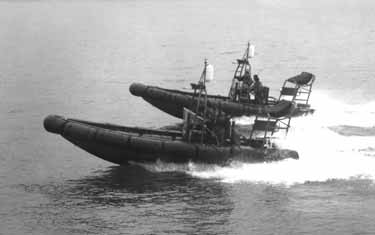 gave pause for thought: there was a feeling among the senior echelons of the Police Force that he had died for a boatload of television sets, and that the strategy used to combat the smugglers should be rethought.
gave pause for thought: there was a feeling among the senior echelons of the Police Force that he had died for a boatload of television sets, and that the strategy used to combat the smugglers should be rethought.
The `daai-feis' probably reached their peak of design in late 1990. Moulded in grey fibreglass, the biggest were anything up to 50 or 60ft (15-18 metres) in length with armoured bows and control positions and open holds big enough to accommodate luxury cars. The engines were mounted on a special transom aft, and on the larger craft there could be five of them - each of 250 or 300 horsepower. In good conditions they could achieve speeds of up to seventy or eighty knots (80-90 mph or 129-145 kph), and with their ruthless coxswains backed by superb organisation they were not vessels to be taken on lightly. Of course, fast as they were, they were not `faster than a speeding bullet' and could fairly easily have been stopped by use of firearms. But Hong Kong was no longer the freebooting place of yore, and the legal right of Marine Police to fire warning shots across the bows of suspect craft - and to fire into them if they persisted in refusing to stop after being told to - had been taken away in the 1970s. Firearms could now only be used when life and limb were threatened; and the many incidents which took place in the early 1990s often developed so quickly that, by the time a situation had reached a stage justifying the paperwork that accompanied even the cocking of a weapon, it was usually too late.
The culmination of several such incidents came on the 3rd June 1990,
when a `daai-fei' deliberately rammed
a SBU craft. Two of her crew were
thrown overboard and the third, 29 year-old
constable Chan Kun-pun, was
killed outright. He was not to be the last Mariner to die in action with
the `daai-feis', but his death at this time
 gave pause for thought: there was a feeling among the senior echelons of the Police Force that he had died for a boatload of television sets, and that the strategy used to combat the smugglers should be rethought.
gave pause for thought: there was a feeling among the senior echelons of the Police Force that he had died for a boatload of television sets, and that the strategy used to combat the smugglers should be rethought.
Various schemes were tried with limited success, but few of them involved the fleet patrol launches, those spanking new vessels whose speed had until now been considered so impressive. Their crews got used to the humiliation of constant ineffectual chases, with the effect on morale that might be expected. Worst affected was North Division, where on one occasion (the night of 2nd August 1990) no less than 30 `daai-feis' zoomed between the division's launches; one of them arrogantly passing within 40ft (12 metres) of an impotent patrol vessel. John Macdonald recalls similar nights off the east coast when the sound of the engines was "...like D-Day! You couldn't see them, but you could hear them - and smell them! Those enormous engines, gulping up the gasoline..."
There was nothing at all haphazard about these smuggling operations: when the `daai-feis' started their high-speed run into territorial waters they were acting under the orders (usually transmitted by mobile telephone) of an `operations director' with lookouts and anything up to 20 spotter and decoy craft at his disposal. Once he had analysed the deployment pattern of the security forces arrayed against him he would decide where the cargo was to be loaded and issue the order. The cargo would already be on the road, contained in nets attached to cranes on the backs of lorries. These would meet the `daai-feis' at the designated spot and the transfer of the nets was usually effected within 30 seconds. Then the `daai-fei' was off and running again while the lorries trundled back for another load.